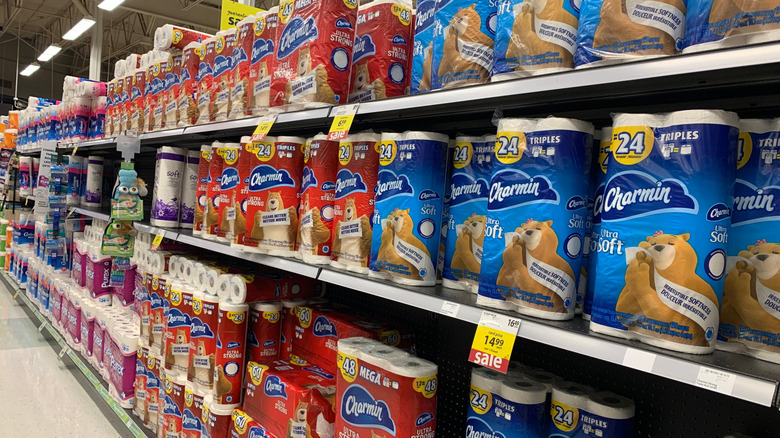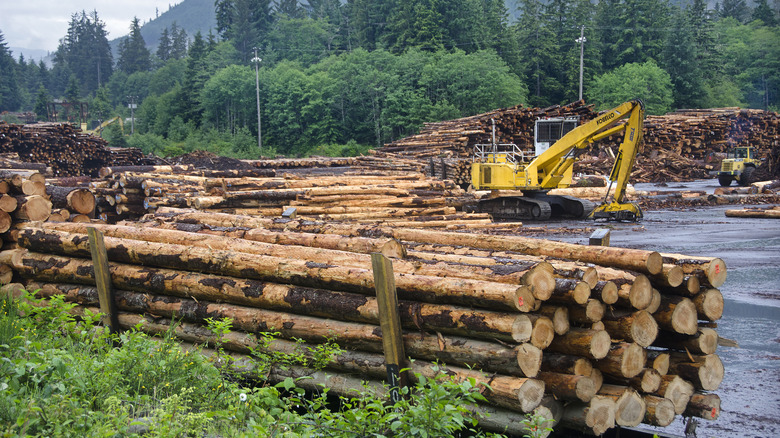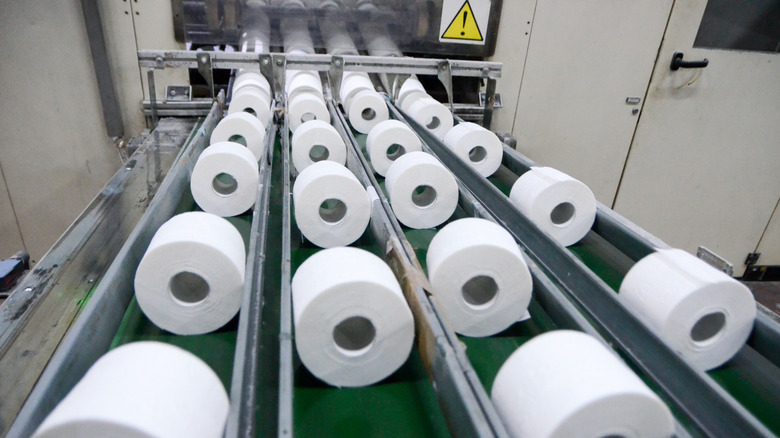Where And How Charmin Toilet Paper Is Actually Made
We may receive a commission on purchases made from links.
Whether you're one of the millions of Americans who fondly remember Mr. Whipple or you're more familiar with the booty shakin' cartoon bears who represent the brand today, you have undoubtedly heard of Charmin toilet paper. During the COVID-19 pandemic, which had toilet paper flying off the shelves, many of us gave less thought to the company's mascots and paid more attention to where we could find a few rolls. Today, most aisles are flush with plenty of toilet paper. But because of where and how Charmin toilet paper is made, the rapidly changing geopolitical climate could once again make it harder than ever to find, let alone squeeze, the Charmin.
Charmin toilet paper is made by Procter & Gamble (P&G), which bought the company in 1957. The popular rolls are made from wood pulp, water-based adhesives, conditioners, and sometimes, lotion. P&G acknowledges that it bleaches the hardwood and softwood pulps used to create its products but says the process is harmless. Environmental organizations disagree, cautioning that you may want to rethink buying the popular brand of toilet paper because the caustic chemicals used to make America's leading roll significantly pollute our waterways.
P&G's manufacturing plant in Pennsylvania produces most of the Charmin you see on the shelves. The company also has other plants, including one in Oxnard, California, a town which has been impacted by the 2025 wildfires. But a significant ingredient in Charmin comes from outside the United States. And it's facing a completely different kind of threat.
Wood pulp is a key component of Charmin toilet paper
The first step in producing Charmin toilet paper is harvesting trees, which are chipped, added to water to create a pulp, and pressed through a series of screens before being rolled into thin sheets. Although the product is produced in the United States, P&G heavily relies on logging Canada's boreal forests in order to create the vast quantities of wood pulp it needs. The company doesn't own or manage the forests. Instead, most are on public lands owned by the Canadian government.
Canadian Forest Owners (CFO), which represents a wide range of members who either own smaller woodlots and private forests or manage vast swaths of provincial crown land, recently sounded the alarm about President Trump's potential 25% tariff on Canadian exports, which include the wood product used to make Charmin toilet paper. According to CFO, if the tariffs go into effect, it will cause a ripple effect throughout the industry, harming Canadian forest owners and driving up material costs to manufacturers like P&G. Ultimately, this is likely to mean you'll either find less toilet paper on the shelves, pay more for it, or both.
Canada isn't the only country on which enacted tariffs may suddenly raise the price and lower the availability of Charmin toilet paper in the US. P&G also sources wood pulp from Latin America, relying on the import of eucalyptus pulp from Brazil, a country that President Trump has also threatened with tarriffs. Financial experts warn that global trade wars could send prices soaring. It's crappy news for anyone who would rather spend less on toilet paper.
Charmin believes it can meet consumer demand
After being pressed into sheets, rolled onto cardboard tubes, and packaged in transparent plastic, Charmin toilet paper is loaded directly onto trucks before being routed to stores nationwide. The vast majority of the United States' toilet paper is manufactured domestically, and Charmin isn't the only brand that's likely to be impacted by sudden changes in commodities pricing.
Although that's an alarming thought for many, there's some comfort to be found from P&G's response to panic buying during the pandemic. When consumers faced bare shelves, the company quickly ramped up production and distribution. In response to the current economic uncertainties, P&G's leadership team recently told Reuters the company is prepared to deal with "whatever the new administration decides to do."
If that doesn't give you some peace of mind, there are other ways to help keep your family clean and hygienic in the event of another Charmin toilet paper shortage or spike in price. Install a bidet in your bathroom, which can drastically reduce the amount of toilet paper you need. Try a Japanese-style toilet like the EPLO modern elongated toilet with warm water and dual auto flush. Buy everyone in the house their own antimicrobial Kula cloth. Or consider stocking up on commercial-grade toilet paper (the type used in public bathrooms), which is made from recycled paper that's sourced domestically. It may not be as soft as Charmin, but it can still do the trick when nature calls.


